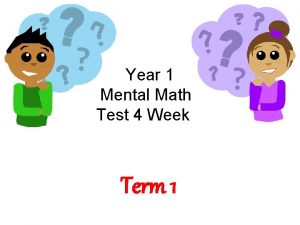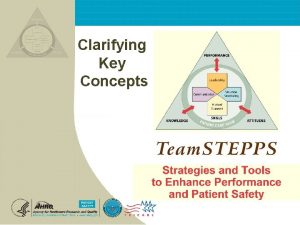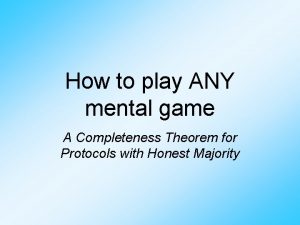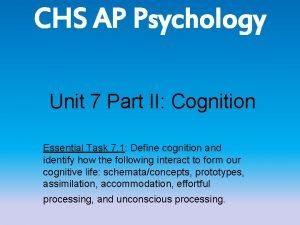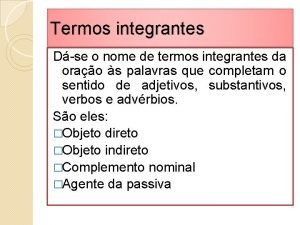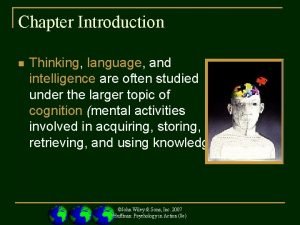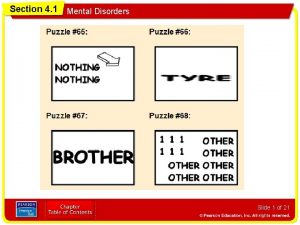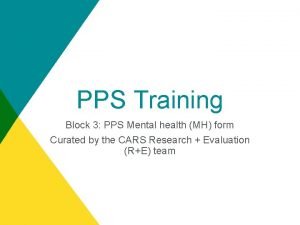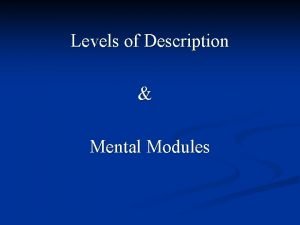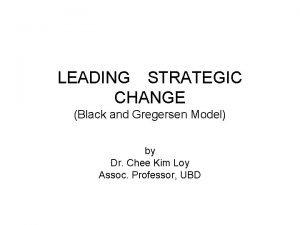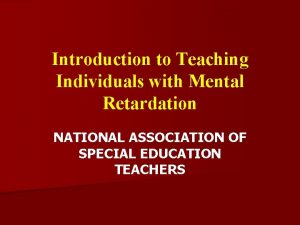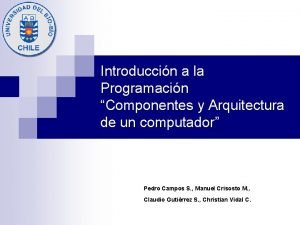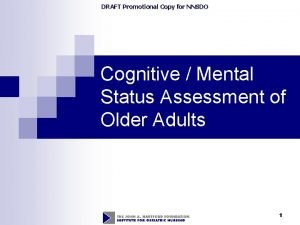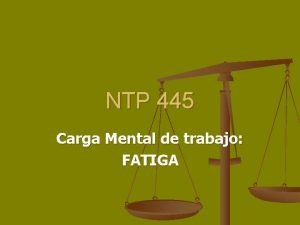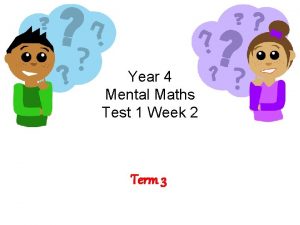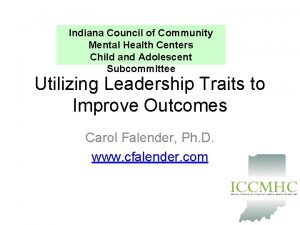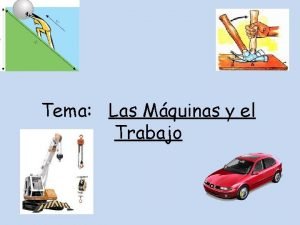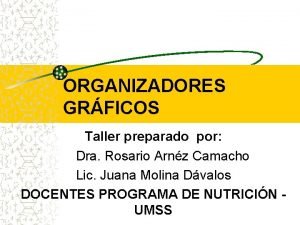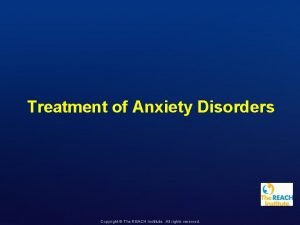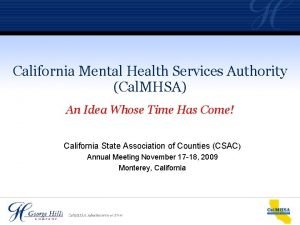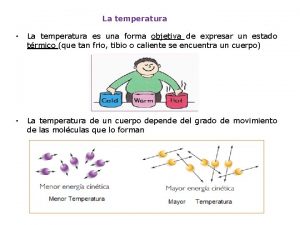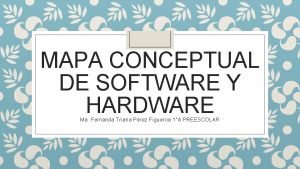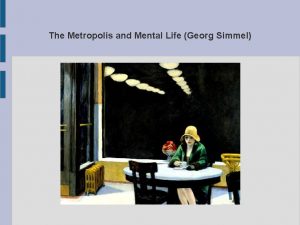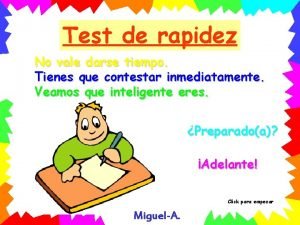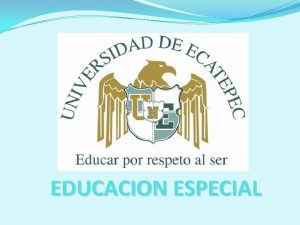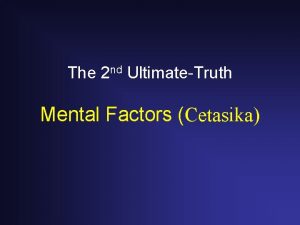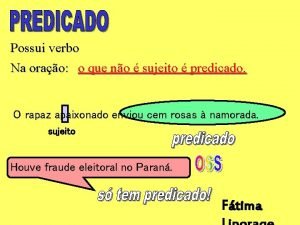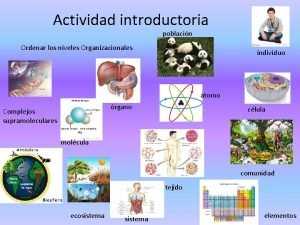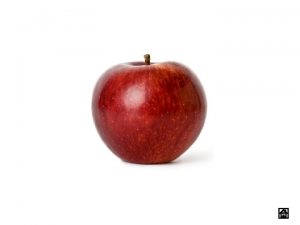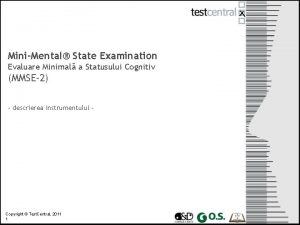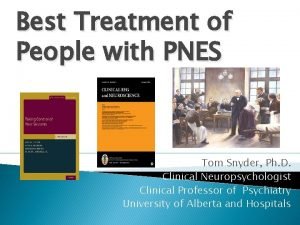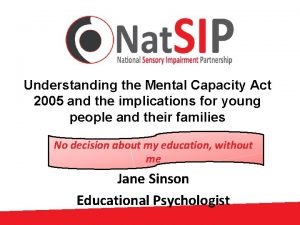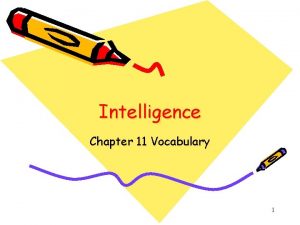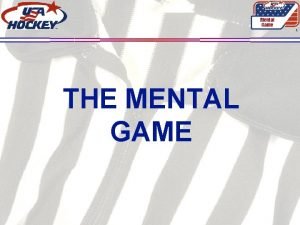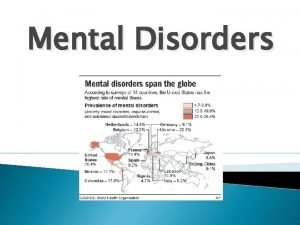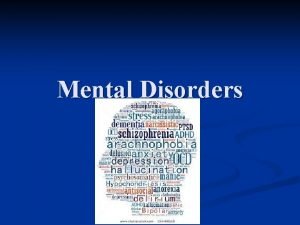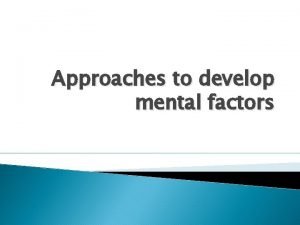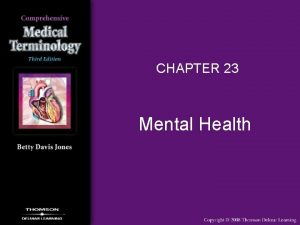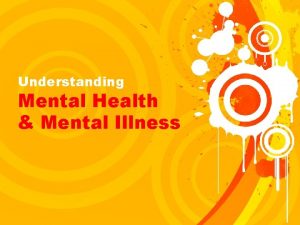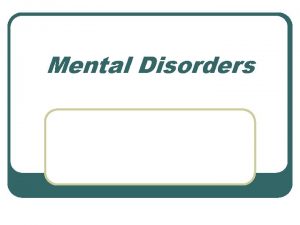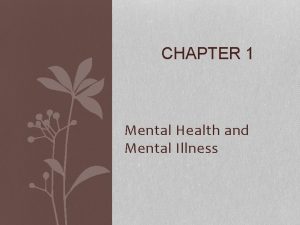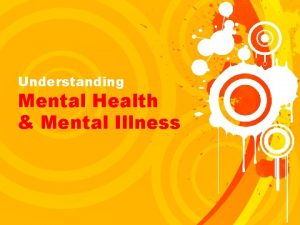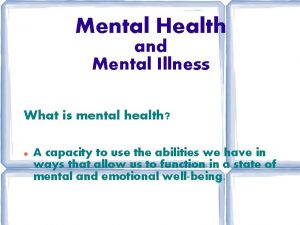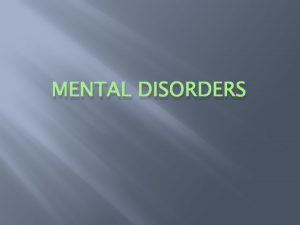Intelligence What is Intelligence l Intelligence mental quality


























































- Slides: 58

Intelligence

What is “Intelligence”? l Intelligence – mental quality consisting of the ability to learn from experience, solve problems, and use knowledge to adapt to new situations

g After finding that schoolchildren's grades across seemingly unrelated subjects were positively correlated, Charles Spearman proposed that these correlations reflected the influence of a dominant factor, which he termed g for "general" intelligence

What is “Intelligence”? l. Is a talented artist who can’t do math “unintelligent”? l Is a brilliant scientist who can’t follow a road map “unintelligent”?

Different cultures deem “intelligent” as whatever attributes enable success in those cultures l Different l l Is intelligence one general ability, or several specific abilities? cultures deem “intelligent” as whatever attributes enable success in those cultures

Theory of Multiple Intelligences l Howard Gardner – – – – – Linguistic Logical-Mathematical Body-Kinesthetic Spatial Musical Interpersonal Intrapersonal Naturalist Existential

Linguistic – words and language l A person's ability to construct and comprehend language l Journalists, poets, novelists, storyteller

Logical-Mathematical – numbers and logic l ability to mentally process logical problems and equations, the type most often found on multiple choice standardized tests l Scientists, accountants, navigator, surveyor

Spatial – pictures l Our ability to comprehend shapes and images in three dimensions. l perceive and interpret that which we may or may not physically see (assemble puzzle, mold a sculpture, etc) l. Artists, cab drivers, architects, chess player

Musical – music l The ability to perform and compose music l Pianist, Composers, singers

Intrapersonal – self-awareness and reflection l allows us to tap into our being - who we are, what feelings we have, and why we are this way. l. Self-help and motivational speakers, philosophers, therapists

Body-Kinesthetic - physical l Each person possesses a certain control of his or her movements, balance, agility and grace. l. Athletes, dancers, craftsperson

Interpersonal – social skills l ability to interact with others, understand them, and interpret their behavior l. Politicians, clergy, salesperson, teacher

Naturalistic – experience in the natural world l People who are sensitive to changes in weather patterns, love the outdoors or are adept at distinguishing nuances between large numbers of similar objects may be expressing naturalist intelligence abilities. l Rangers, Guides, Environmentalists, Zoologist

Existential Intelligence l Individuals who exhibit the proclivity to pose (and ponder) questions about life death, and ultimate realities l. Philosophers and Thinkers - Aristotle, Confucius, Einstein, Plato, Socrates

Triarchic Theory of Multiple Intelligences l. Robert Sternberg -Analytical -Creative -Practical

Analytical – l Assessed by intelligence tests, that have single right answers; Problemsolving strategies and their correct applications to real-life issues. Commonly referred to as “book smarts”.

Creative Intelligence l – the ability to effectively deal with novel situations by drawing on existing skills and knowledge.

Practical Intelligence the ability to adapt to the environment, reflecting was is commonly called “street smarts”.

Cluster Intelligence l Louis l l Thurstone There are seven different primary mental abilities. The scores for each of the seven tests of intelligence is read separately in order to get a better understanding of strengths and weaknesses

Verbal comprehension (or Verbal Ability): l Found in such things as verbal reasoning, reasoning by analogy, and reading comprehension. It is "characterized primarily by its reference to ideas and the meanings of words. "

Word fluency: l Facility with words in special contexts, such as anagrams, rhyming, etc.

Number ability: l Arithmetic computation

Spatial ability: l The ability to mentally manipulate and visualize geometric relations; facility in spatial and visual imagery.

Associative memory: l The ability to make random paired associations that require rote memory; memorizing skills.

Perceptual speed: l Facility in finding or in recognizing particular items in a perceptual field.

General reasoning ability (or Induction): l Facility in finding rules or principles in test items, such as in a number series.

Emotional Intelligence l Salovey l and Mayer Gardner’s Multiple Intelligences PLUS: – Emotional Intelligence – superb social skills, manages conflicts well, and has great empathy for others

Creative Intelligence – Aha! l Andrew Wiles: – – Creativity is the ability to produce ideas that are both novel and valuable There are five components of a creatively intelligent person: l Expertise l Imaginative Thinking Skills l A Venturesome Personality l Intrinsic Motivation l A Creative Environment

l Expertise is a well-developed base of knowledge l Imaginative Thinking Skills provide the ability to see new things, to recognize patterns, and to make connections

l A Venturesome Personality tolerates ambiguity and risk, perseveres in overcoming obstacles, and seeks new experiences apart from the group l Intrinsic Motivation is the personal pleasure derived from the challenge of the work

l. A Creative Environment sparks, supports, and refines creative ideas.

Intelligence Anomalies l Savant Syndrome – a condition in which a person otherwise limited in mental ability has an exceptional specific skill, such as in computation or drawing; some people are functionally retarded in almost every aspect except for one very specific ability.

Intelligence and the Brain l Correlational studies have suggested that brain size and intelligence are positively correlated l Brain analyses have suggested that more intelligent people have more neural connections

Intelligence and the Brain l Studies suggest that more intelligent people have faster perceptional skills and brain reaction speeds

Assessing Intelligence l How is intelligence determined? Testing

Two Types of Intelligence Tests l Aptitude Test – a test designed to predict a person’s future performance; aptitude is the capacity to learn l Achievement Test – a test designed to assess what a person has already learned

One Example of an Achievement Test is an IQ Test l Intelligence Test – a written method for assessing an individual’s mental aptitudes and comparing them with those of others, using numerical scores – Student A got a 1300 SAT score, while Student B got a 900 SAT score. Student A is “more intelligent”.

IQ Tests l Stanford-Binet – the most widely used written intelligence test l Wechsler Adult Intelligence Scale (WAIS)– the most widely used intelligence test; contains verbal and performance (nonverbal) subtests

Alfred Binet • The 1 st widely utilized intelligence Test l 1904 l Developed a test to identify French school children in need of alternative education

The Stanford-Binet IQ Test l 1916 Louis Terman, Stanford University l Felt that IQ was inherited and that tests would be a great way to classify children l Adjusted the test for English speaking students and utilized a colleague’s formula to derive a person’s “IQ” or “Intelligence Quotient”

How do you determine IQ? Step 1 l Mental Age – a measure of intelligence test performance devised by Binet; the chronological age that most typically corresponds to a given level of performance. – A child who does as well as the average 8 -year-old is said to have a mental age of 8.

How do you determine IQ? Step 2 l Intelligence Quotient (IQ) – defined originally as the ratio of mental age (ma) to the chronological age (ca), multiplied by 100. (MA / CA) X 100 – An 8 -year old student that takes an IQ Test scores as well the average 10 -year old. – 10/8 = 1. 25 X 100 = 125 IQ

IQ Scale l l l l Over 140 - Genius or near genius 120 - 140 - Very superior intelligence 110 - 119 - Superior intelligence 90 - 109 - Normal or average intelligence 80 - 89 - Dullness 70 - 79 - Borderline deficiency Under 70 - Definite feeble-mindedness

l Normal Curve – the symmetrical bell-shaped curve that describes the distribution of many physical and psychological attributes. Most scores fall near the average, and fewer scores lie near the extremes

l The “normal curve” for IQ ranges from 85 -100, plus or minus 15. About 95% of all scores fall into the range of 70130. About. 01% score below 55 or higher than 145.

l Mental Retardation – a condition of limited mental ability, indicated by an intelligence score below 70 and difficultly in adapting to the demands of life; from mild, to profound

Constructing An Intelligence Test

1. Establish A “Standard” l Standardization – defining meaningful scores by comparison with the performance of a pretested “standardization group” – The “control” test group (a representative sample of the entire population you are comparing scores to) scored an average of 1000 on the SAT. You scored a 1200 on the SAT. You are “above” the standard.

2. Is The Test “Reliable”? l Reliability – the extent to which a test yields consistent results, and how well it can be replicated

2. Checking Reliability – – Split-Half Reliability – Half of the students answer all of the odd questions, the other half answer all of the even questions on a test. The scores should be similar if the test is consistently testing the same knowledge. Equivalent Form – Students who receive Form A of a test should score similarly to those students who received Form B regarding the same information.

3. Is The Test “Valid”? l. Validity – the extent to which a test measures or predicts what it is supposed to

3. Checking Validity l Content Validity – the extent to which a test samples the behavior that is of interest – If a test is supposed to test your knowledge of mathematical principles, the questions should be on math, not history or writing skills

3. Checking Validity l Predictive Validity – the success with which a test predicts the behavior it is designed to predict; it is assessed by computing the correlation between test scores and the criterion behavior – Is a test is designed to measure mechanical aptitude, people who receive high scores should ultimately prove more successful in mechanical jobs than people that scored low

Reliability and Validity l It is possible to have a test that is reliable, but not valid. Such a test consistently measures something, but not what it is intended to measure. – IE. A vocabulary test given in math class is reliable as far as testing vocabulary, but is not a valid measure of a student’s mathematical intelligence.

Reliability and Validity l It is impossible to have a test that is valid, but not reliable. If individual scores fluctuate wildly, then they cannot consistently correlate with other scores, whatever those scores may be. – Tests cannot be accurately measuring a given set of material if scores on those tests vary wildly. On multiple tests of a single mathematical principal you score an 89, 34, 56, and a 99, the tests cannot have been consistently testing the same material, nor can they be good indicators that you know or don’t know the material.

Gender Similarities and Differences l Girls are: – – – – More verbally fluent Better spellers More sensitive to touch, taste, and odor More capable of remembering words and the locations of objects Higher scoring in math computation tests Better at detecting emotions Higher scoring on tests of recognition

Gender Similarities and Differences l Boys: – Outnumber girls in special education classes – Talk later – Read later – Score higher on math problem solving tests – Score higher on tests of spatial ability – Score higher on tests related to the sciences – Are less emotionally sensitive
 Mental health and mental illness chapter 20
Mental health and mental illness chapter 20 Mental illness mental health jeopardy
Mental illness mental health jeopardy David wechsler ap psychology
David wechsler ap psychology Juran's three role model
Juran's three role model Quality assurance cycle in nursing
Quality assurance cycle in nursing Quality is free: the art of making quality certain
Quality is free: the art of making quality certain Quality control and quality assurance
Quality control and quality assurance Quality improvement vs quality assurance
Quality improvement vs quality assurance What is tqm
What is tqm Project quality management pmp
Project quality management pmp Qa basic concepts
Qa basic concepts Quality metrics pmp
Quality metrics pmp John locke
John locke Mental wellbeing impact assessment
Mental wellbeing impact assessment King county mental health court
King county mental health court What is mental health
What is mental health Mental maths test year 1
Mental maths test year 1 Ipassthebaton
Ipassthebaton How to play any mental game
How to play any mental game Embodied cognition ap psychology
Embodied cognition ap psychology Objeto indireto
Objeto indireto What are the barriers to problem-solving in psychology
What are the barriers to problem-solving in psychology Section 4-1 mental disorders answers
Section 4-1 mental disorders answers Pps mental health
Pps mental health Mental modules definition
Mental modules definition Ciclo da ureia
Ciclo da ureia Mobile outreach safety team reno
Mobile outreach safety team reno Management of challenged children
Management of challenged children Strategic change matrix
Strategic change matrix Mental health definition
Mental health definition Mapa mental de software y hardware
Mapa mental de software y hardware Mental status examination purpose
Mental status examination purpose Ntp carga mental
Ntp carga mental Year 4 mental maths tests
Year 4 mental maths tests Indiana council of community mental health centers
Indiana council of community mental health centers 3 ejemplos de maquinas simples
3 ejemplos de maquinas simples Douglas county mental health initiative
Douglas county mental health initiative Organizadores
Organizadores Moving on mental health
Moving on mental health Reach institute mental health
Reach institute mental health Conclusion of mental retardation
Conclusion of mental retardation California mental health services authority
California mental health services authority Older adults mental health
Older adults mental health Tipos de dilatación
Tipos de dilatación Hardware y software mapa conceptual
Hardware y software mapa conceptual Simmel metropolis and mental life summary
Simmel metropolis and mental life summary Prueba mental tienes 1000 súmale 40
Prueba mental tienes 1000 súmale 40 Que es retardo mental
Que es retardo mental 52 mental factors
52 mental factors Tipos de predicado
Tipos de predicado Mapa mental de los organelos
Mapa mental de los organelos What is mental health
What is mental health Pensamiento irradiante ejemplos
Pensamiento irradiante ejemplos Gulf coast center angleton texas
Gulf coast center angleton texas Mmse-2
Mmse-2 Disaster means
Disaster means Thomas snyder mental health
Thomas snyder mental health 5 mca principles
5 mca principles Lenawee county community mental health
Lenawee county community mental health
















